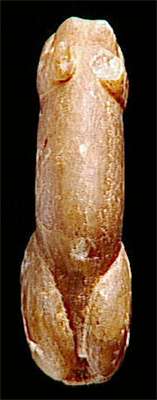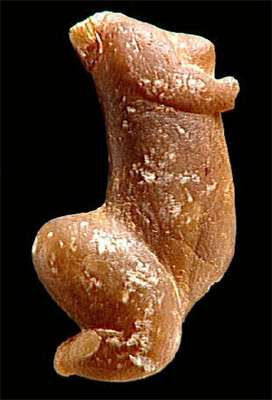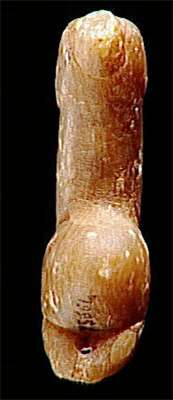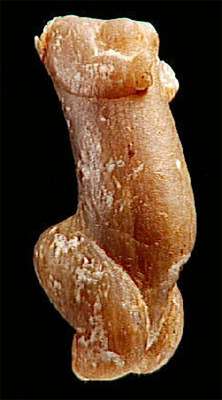Back to Don's Maps
Back to Venus figures from the Stone Age
Venus of Sireuil, Roc de Cazelle, Dordogne
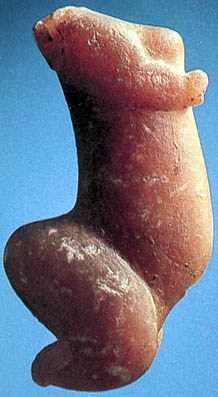
The Venus de Sireuil was collected in 1900 in the Dordogne. It is made of calcite.
Photo: Unknown
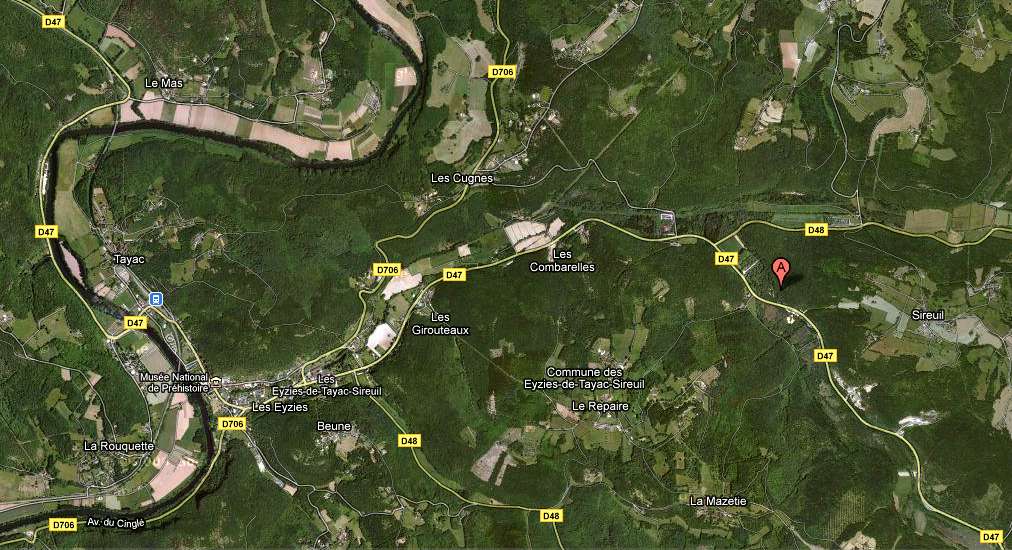
Photo: Google Maps
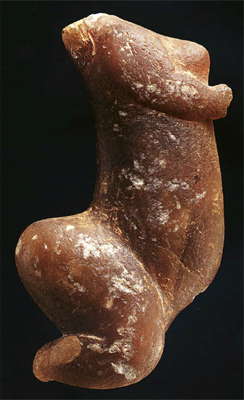
Sireuil Venus
It was carved from an amber calcite pebble, and was found in the rut of a road from the Goulet de Cazelle near Sireuil village. This photo shows clearly the damage that the venus suffered before being picked up from the road.
Photo: Roger Joussaume, CNRS
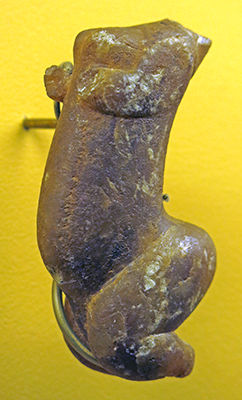

Sireuil Venus
Dimensions: Height 91 mm, width 41 mm, depth 27 mm.
Photo: Don Hitchcock 2014
Catalog: MAN75664
Source: Original, Musée d'Archeologie Nationale et Domaine, St-Germain-en-Laye
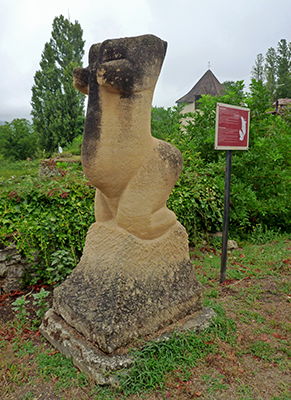
This is a larger than life size sculpture of the venus in the little village of Sireuil.
Photo: Ralph Frenken 2015
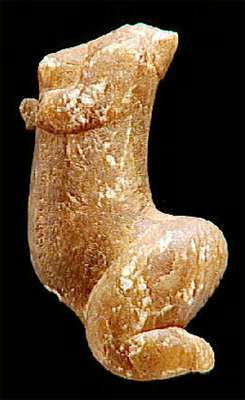
Views of the Sireuil Venus
A female figure carved in a graceful profile, arms raised, held under the breasts. The head and torso are fractured. The legs are short but massive and bent in a kneeling position. A hole made between the lower legs could perhaps be used to insert a stick to hold the statue upright, or so that it might be used as a pendant.
The abdomen and buttocks are protuberant, and the back is arched. There is, between the Tursac and Sireuil venuses an undeniable kinship of style, pose and material.
Photos and text adapted and translated from: http://www.culture.gouv.fr/
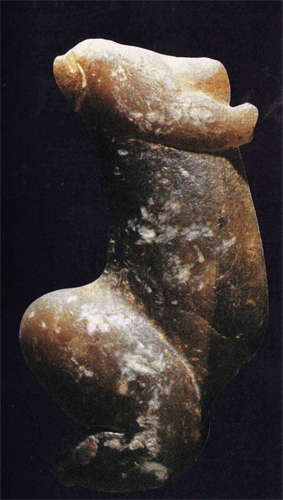
Another version of the Sireuil Venus.
Photo: http://www.jacquesvlemaire.be/blog/tag/venus-a-la-corne
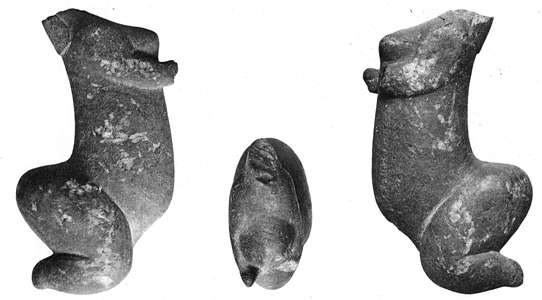
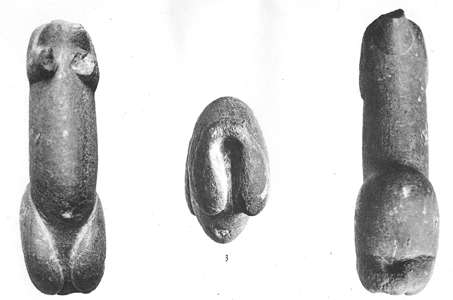
The Sireuil Venus from a number of perspectives.
Photo: Breuil et Peyrony (1930)
Text below from:
Breuil et Peyrony (1930)
It was in 1900 that M. Prat, of Manaurie, near Les Eyzies (Dordogne), handed to one of us (D. Peyrony) the small calcite statuette which is the subject of this article. He had at picked it up at the 'Goulet Cazelle', or Cazelle Gully, Commune Sireuil, in a rut in the road just past a small quarry. The wheel of a cart loaded with large stones which he was accompanying, had pushed its head into the mud. It was thus quite fortuitous that the figurine was discovered and rescued. M. D. Peyrony gave it to Dr. Capitan, who gave it to the Museum of National Antiquities in Saint-Germain-en-Laye, to put with all its prehistoric collections.
The Sireuil Venus
The 'Venus of Sireuil' (MAN 75664), carved into an amber calcite pebble (fig. 25b) like Tursac, was found in the rut of a road from the Goulet de Cazelle near Sireuil village (Breuil et Peyrony 1930). The head was damaged as well as the upper limbs. The lower limbs terminate in 'spheres', similar to Milandes and Pataud. The back, largely natural, is arched and the abdomen is thrown forward as is the Milandes. Buttocks and thighs were highlighted by an engraved line marking the waistline and the crease between the abdomen and thighs. A few flints were found in the vicinity, including an alleged Aurignacian carinated scraper, but the dating of this sculpture is still very uncertain. Although it is much more elaborate than the statue of Milandes, there are some morphological similarities (in profile) and techniques between these two objects. The Venus of Sireuil, 90 mm high is slightly taller than that of Milandes.
Microscopic analysis of the Venus de Sireuil (fig. 28, 29, 30, 31) reveals clear marks of scraping and cutting with flint. The bottom of some grooves forming the contours are V-shaped. The surface, in places, despite recent damage from the context of its discovery, shows traces of scratching, a little weathered, similar to the statue of Milandes (fig. 32).
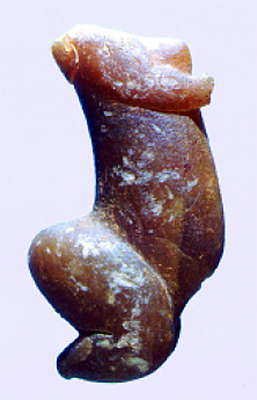
Fig. 25b - The Venus of Sireuil
Photo: MAN
Source: White (2002)
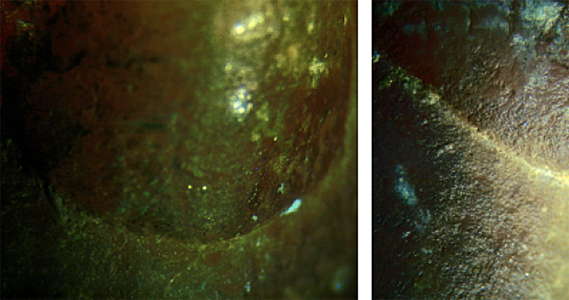
Fig. 28 (left) - The Venus of Sireuil. The curved incision defining the base of the hair. Compare with fig. 14 and 19 (6.4x).
Fig. 29 (right) - The Venus of Sireuil. Fine curved incision marking the lower limit of the arms, with subtle traces of scraping beneath. Compare with fig. 13 and 19 (6.4x).
Photo: R. White
Source: White (2002)
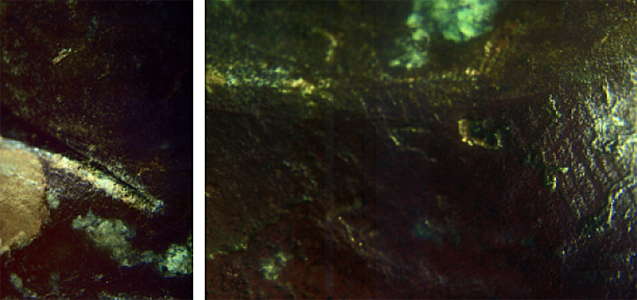
Fig. 30 (left) - The Venus of Sireuil. Extremity of a V-profiled
incision marking the knee fold (6.4x)
Fig. 31 (right) - The Venus of Sireuil. Lithic tool stigmata in the bottom
of an incision. Beneath the incision are visible parallel striations
from scraping, very similar to stigmata observed on the
Milandes statuette. Compare with fig. 13 (18x).
Photo: R. White)
Photo: R. White
Source: White (2002)
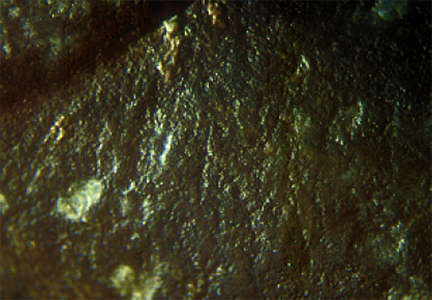
Fig. 32 - The Venus of Sireuil. Scraping stigmata adjacent to an incised line, very similar to stigmata on the Milandes statuette. Compare with fig. 11, 12 and 15 (18x).
Photo: R. White
Source: White (2002)
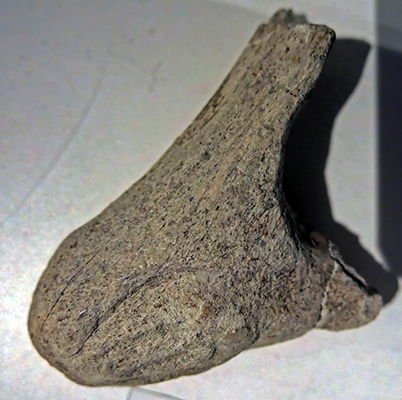
Engraved bone from Vieilmouly, Sireuil.
Material: Bone
Age: Recent Palaeolithic
Photo: Don Hitchcock 2015
Source: Original, Musée d'Aquitaine à Bordeaux
Étude comparative des statuettes féminines de Sireuil et Tursac
Translated and adapted from the French by Don Hitchcock
The statuette of Sireuil was found in 1900 by M. Prat, on the road to a stone quarry, at a place called Goulet-de-Cazelle, ( or Vallon du Goulet, or le Goulet, about a kilometre upstream along the Petite Beune from Roc de Cazelle - Don) in the commune of Sireuil, ( now the commune of Les Eyzies-de-Tayac-Sireuil since 1972 ) near Les Eyzies-de-Tayac in the Dordogne. A cartwheel which ran over it in the muddy rut where it lay unfortunately amputated the head and left hand which were not recovered. The material of the object is of amber calcite, slightly translucent, measuring 92 mm high, width of 27 mm and depth 41 mm. H. Breuil and D. Peyrony published a good description thirty years after its discovery in 1930. Aurignacian flint was found 150 metres from the statue, in a quarry. It is estimated to be 25 000 years old.
The presence of breasts shows that the statue is of a female. There is no nipple, but in its place a small cup, as in some patients with inverted breasts (about 7% of our clients), but the absence could also simply be due to a technical aspect, because we observe something comparable in figures clearly representative of parous (having given birth one or more times) women and nurses, as in Willendorf I. There is no indication of external genitalia but the other female secondary sexual characters are convincing, involving a pelvic-femoral segment rather strongly developed and wider hips than shoulders (32 mm against 25 mm), and strong projection of the buttocks.
H. Breuil and D. Peyrony found that the statue was steatopygous ( the buttocks were exaggerated ), although Passemard (1938), and Regnault (1931) and Pales (1972) disagreed, the latter asserting that extending the limbs, and an arching lumbar region and gluteal projection sufficed. It does not seem to us possible to agree that the lumbosacral angulation can disappear with the extension of the lower limbs and that these buttocks departing at right angles, like those of the "Polichinelle" of Grimaldi, are simply a physiological effect of the posture.
The volume of the abdomen is important, it presents a strong and regular projection from the chest to the pelvis, with a pubo-umbilical line strongly oblique towards the top. It is, in our view, a pregnant abdomen. The identification of the posture of this young woman is not unanimous: "lying on the belly" for H. Breuil and D. Peyrony who admitted however that the object was designed to be worn suspended through a hole between the feet. She was kneeling for F. Regnault and squatting for Delporte (1979).
H. Delporte drew a parallel with the statuette of Tursac, imagining the statuette to be vertical and supported by a rod inserted into the conical hole placed between the feet, but noted that it shows no sign of wear.
We believe that this young pregnant woman can be seen in the supine position, resting on the back of her head and her buttocks, back arched, hence the orientation of the breasts towards the top of the figure. If the Lespugue statue presents a rare example of orientation of the arm away from the median line of the body, this offers another example, also uncommon in the round, of the forearms towards the front of the body.
It is especially in the Magdalenian, and in engravings, that this position exists. She is described in an attitude of "praying", although it is difficult to prove whether a gesture of supplication or prayer or any other explanation could be advanced without the benefit of certainty. Without doubt this body is not the depiction of an actual person, and on this point, opinion is unanimous. But we are used to deformations of the body in Paleolithic statuary, with reduction of members and accented morphophysiological characters, Here, three seem to be important:
• the juvenile aspect of the breast
• the prominence of the abdomen;
• the strong development of pelvic-femoral segment with a sharp protruding buttocks and large lumbosacral angle.
Small breasts, big belly, heavy buttocks and the absence of obesity encourage us to see in this figure a pregnant woman with posterior steatopygia.
Text above: Duhard (1993)
References
- Breuil H. et Peyrony D., 1930: Statuette feminine aurignacienne de Sireuil, Dordogne, Revue Anthropologique, XL, 1930. 21
- Delporte H., 1979: L'image de la femme dans l'art préhistorique, Paris, Picard.
- Duhard J., 1993: Étude comparative des statuettes féminines de Sireuil et Tursac (Dordogne), Bulletin de la Société Historique et Archéologique du Périgord, 77, p.55-64.
- Pales L., 1972: Les ci-devants venus stéatopyges aurignacienne, Sanlander Symposium,p. 217-261.
- Passemard L., 1938: Les statuettes féminines paléolithiques dites venus stéatopyges, Nîmes, Tessier.
- Regnault F., 1931: La statuette de Sireuil et la Reine de Pount ne sont pas stéatopyges, Bulletin de la Société Préhistorique Française, 28, p. 262-264.
- White, R. , 2002: Une nouvelle statuette phallo-féminine paléolithique: 'La venus des Milandes' (commune de Castelnaud-la-Chapelle, Dordogne), Paleo N° 14 Décembre 2002 – Pages 177 à 198

